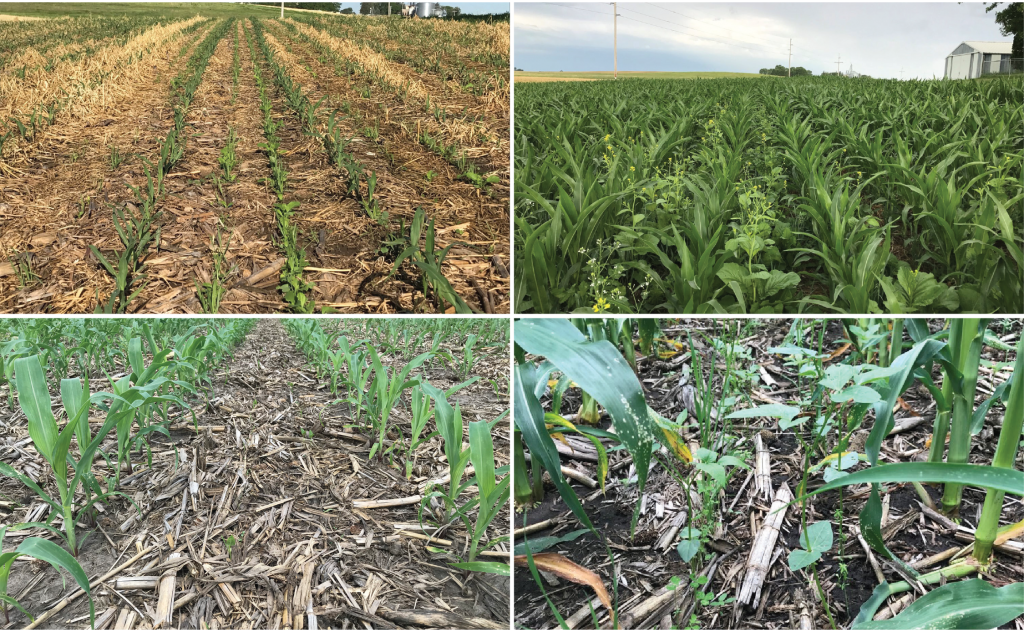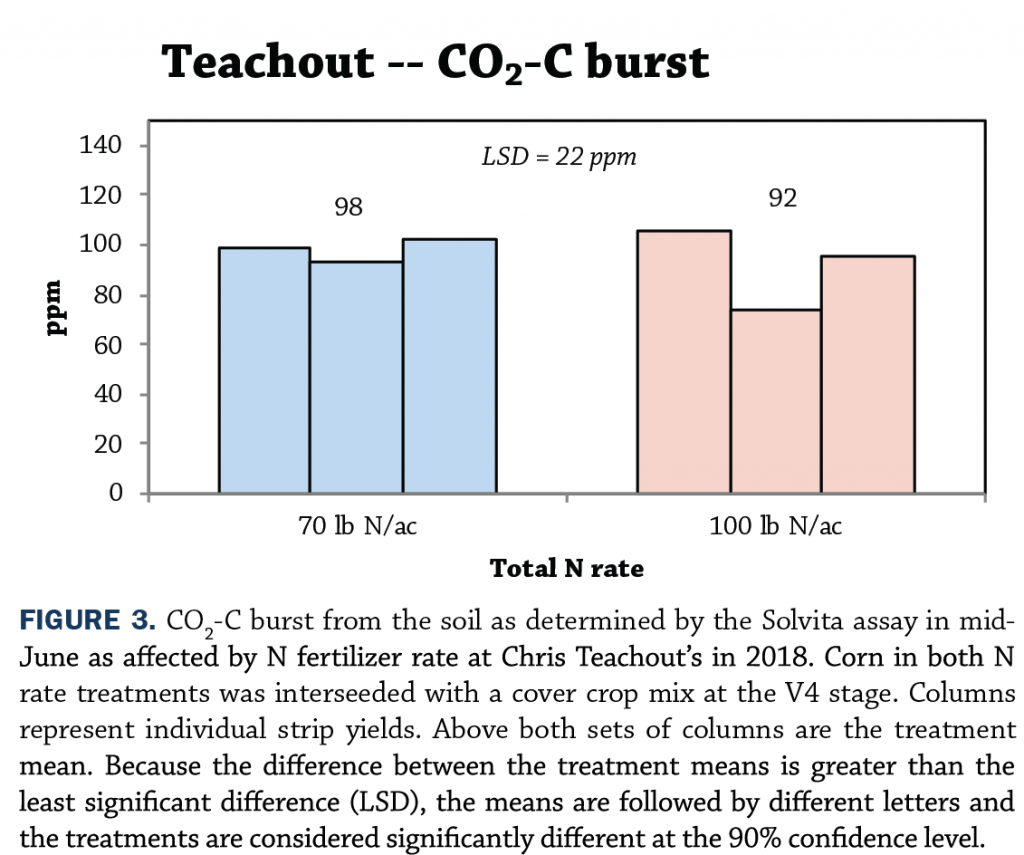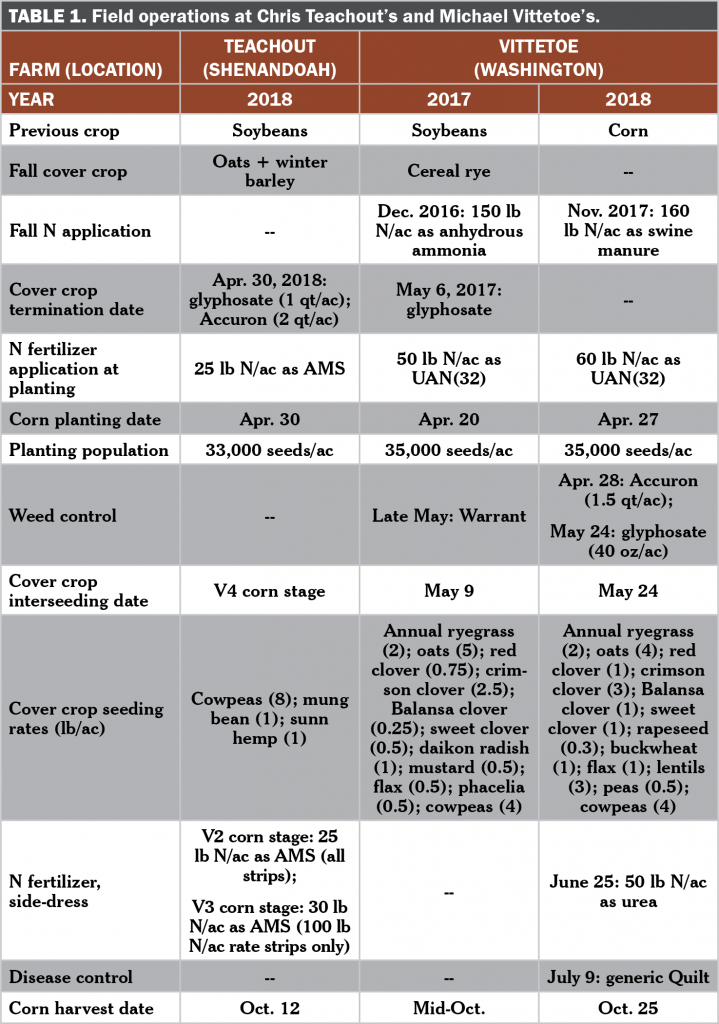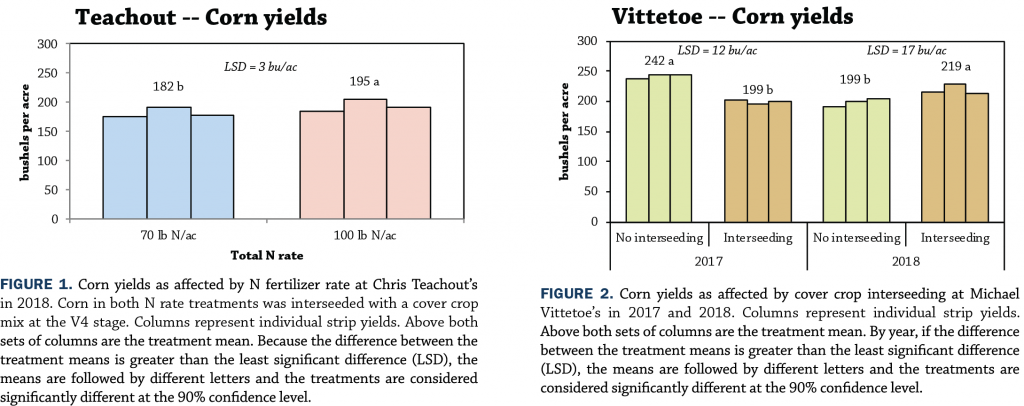This project was supported by the Walton Family Foundation
In a Nutshell:
- Interseeding cover crops to corn at the V4 stage has gained attention for its potential to foster successful diverse species mixes and generate more biomass than a fall-seeded cover crop.
- Cooperators in these experimental trials explored the effect of interseeding a cover crop mix and N fertilizer rate on corn yields.
Key Findings
- Chris Teachout compared two N rates (70 and 100 lb N/ac) after interseeding his entire corn field with a cover crop mix of legumes. Yields were greater by 13 bu/ac in the 100 lb N/ac treatment.
- Michael Vittetoe compared corn yields resulting from a cover crop interseeding to no interseeding over two years. In 2017, the interseeding reduced yields by 43 bu/ac; in 2018, the interseeding improved yields by 20 bu/ac. The 2018 experiment was conducted in the same strips as in 2017. Soil improvement by the cover crop growth in 2017 may have had a positive effect on the corn that followed in 2018.
Background
While cover crops in the Upper Midwest are typically established in late summer or early fall after cash crop harvest, this strategy limits viable cover crop options to winter hardy small grains species like cereal rye or winter wheat. Seeding cover crops earlier in the growing season presents opportunities for including more species diversity. Recent studies in South Dakota showed that corn yields were not compromised after cover crop mixes were seeded to the corn in late June at the V5 stage of corn development.[1] Previous research by Practical Farmers cooperators has found it challenging to successfully establish cover crops when interseeding to corn early in the season when the corn is at the V2 to V4 stage. Jack Boyer had success interseeding cover crops to seed corn. The cover crops survived through the summer and had no negative effect on seed corn yield compared to the no-cover control.[2] Seed corn allows for much more sunlight penetration through the crop canopy to the soil surface than field corn. As such, both Boyer and Jeremy Gustafson assessed interseeding cover crops to corn hybrids with horizontal and vertical leaf orientations. Neither saw a difference in cover crop growth between the corn leaf orientations and Boyer saw a yield reduction from the interseeded cover crops compared to a no-cover control.[3] Most recently, cooperators investigated 60-in.-wide corn rows for interseeding cover crops. Two farms saw similar corn yields to corn grown in 30-in. row-widths; two other farms saw reduced yields with the wider rows.[4] In general, the wider corn row-width resulted in far more cover crop growth.

Michael Vittetoe interseeded a cover crop mix to corn on May 24, 2018. The corn
was planted 33 days earlier on Apr. 27.
Chris Teachout and Michael Vittetoe have tried interseeding cover crops to corn in small patches of their fields the past few years. Both decided it was time to investigate the practice in experimental trials. “I’ve been hoping to make interseeding a bigger part of our corn program in the future so conducting trials will help us learn how to make that happen.” Vittetoe said at the onset of the study. “We might as well work with PFI to help others learn about the practice,” he added.
Objective: Determine the effect on corn yield of a cover crop interseeded to corn near the V2 corn development stage.
Methods
These experimental trials were conducted by Chris Teachout near Shenandoah in Fremont County and Michael Vittetoe near Washington in Washington County. Teachout interseeded a cover crop mix to standing corn and compared the effect of N fertilizer rate (70 and 100 lb N/ac) on corn yield. Nitrogen rate treatments were replicated three times in randomized strips. Vittetoe evaluated the effect of interseeding a mix of cover crops to standing corn on corn yields compared to where no cover crops were interseeded in both 2017 and 2018 (trial in 2018 occurred in the same field as in 2017). Interseeding and no-interseeding treatments were replicated three times in randomized strips. Crop management details for both farms are provided in Table 1.
Teachout collected soil samples to a depth of 6-in. on June 11. Samples were sent to AgSource Laboratories (Ellsworth, IA) to determine the burst of CO2-C following rewetting of dried soil using the Solvita assay. Corn was harvested individually from each strip and corrected to 15.5% moisture.
Data were analyzed using JMP Pro 13 (SAS Institute Inc., Cary, NC) statistical software. Means separations are reported using the least significant difference (LSD) generated by a t-test. Statistical significance was determined at the 90% confidence level.
Results and Discussion
Corn yields
At Teachout’s, the 100 lb N/ac N fertilizer rate resulted in greater yields by 13 bu/ac than the 70 lb N/ac fertilizer rate (Figure 1). Yields from the 100 lb N/ac fertilizer rate exceeded the five-year Shenandoah County average of 183 bu/ac,[5] while yields from the 70 lb N/ac N fertilizer rate fell just below that average.
Corn yield response to interseeding differed between the two years at Vittetoe’s. In 2017, interseeding resulted in a yield reduction of 43 bu/ac compared to no interseeding (Figure 2). Vittetoe blames the reduced corn yields on the tremendous amount of cover crop growth that occurred from the interseeding in early May 2017. That year, he interseeded the cover crop on May 9; 19 days after planting corn (Table 1). By mid-June, some of the cover crops were nearly as tall as the corn (photos below). This likely resulted in competition for water and nutrients with the corn (much like weeds) and reduced yield potential.
In 2018, corn yields were greater in the interseeding treatment by 20 bu/ac (Figure 2). Compared to 2017, Vittetoe observed far less growth and competition from the interseeded cover crops in 2018 that were interseeded on May 24; 33 days after planting corn (Table 1).
“We took a big yield hit from the interseeding in 2017, but all of that cover crop probably helped yields in 2018,” Vittetoe said. Recall that Vittetoe repeated the trial in 2018 in the same location and strips as in 2017. It very well could have been that the large amount of cover crop growth in 2017 improved soil conditions relative to where no cover crop was interseeded. The cover crop mix was made up primarily of legumes and legume cover crops are known to improve corn yields.[6] Across both years, corn yields at Vittetoe’s exceeded the Washington County average of 195 bu/ac[5] regardless of interseeding.

Top row, Interseeded cover crops at Michael Vittetoe’s on May 28 (left) and June 21 (right) in 2017. Cover crops were interseeded to corn on May 9 (19 days after
planting corn). Bottom row, Interseeded cover crops at Michael Vittetoe’s on May 30 (left) and June 20 (right) in 2018. Cover crops were interseeded to corn on May 24
(33 days after planting corn).
Solvita soil CO2-C burst
Teachout collected soil samples from all strips in June to determine any soil health differences between N rate treatments. The Solvita assay determines soil microbial activity by measuring the amount of CO2-C respired over a 24-hour period from a dried soil sample that has been rewetted and held at an ideal temperature. At Teachout’s, the N rate did not have an effect on the CO2-C soil burst (Figure 3).
 Conclusion and Next Steps
Conclusion and Next Steps
These experiments performed by Teachout and Vittetoe explored the effects on corn of a cover crop interseeded to the corn in mid-spring once the corn reached the V2-V4 stage. Teachout interseeded cover crops to an entire field of corn compared two N fertilizer rates (70 and 100 lb N/ac). The 100 lb N/ac rate resulted in greater yields by 13 bu/ac (Figure 1) but no improvement in soil health (Figure 3). Vittetoe compared strips of corn that were either interseeded with a cover crop mix or not interseeded in both 2017 and 2018. An earlier interseeding date in 2017 (19 days after planting corn) resulted in far more cover crop growth than in 2018 (33 days after planting corn). The strips in 2018 were the exact same strips from 2017. The interseeding resulted in a yield reduction of 43 bu/ac in 2017, but in 2018 the interseeding improved yields by 20 bu/ac. Vittetoe estimated that the better yields in the interseeding strips in 2018 could have resulted from the large amount of cover crop growth (and attendant benefits to soil conditions) from the interseeded strips in 2017.
Appendix – Weather Conditions
References
- Bich, A.D., C.L. Reese, A.C. Kennedy, D.E. Clay and S.A. Clay. 2014. Corn Yield Is Not Reduced by Mid-Season Establishment of Cover Crops in Northern Great Plains Environments. Crop Management. 13:0. https://dl.sciencesocieties.org/publications/cm/abstracts/13/1/CM-2014-0009-RS (accessed May 2019).
- Gailans, S. and J. Boyer. 2016. Interseeding Cover Crops in Seed Corn at the V4-V6 Stage. Practical Farmers of Iowa Cooperators’ Program. https://practicalfarmers.org/research/interseeding-cover-crops-in-seed-corn-at-the-v4-v6-stage/ (accessed May 2019).
- Gailans, S., J. Boyer and J. Gustafson. 2017. Corn Leaf Architecture for Interseeded Cover Crops. Practical Farmers of Iowa Cooperators’ Program. https://practicalfarmers.org/research/corn-leaf-architecture-for-interseeded-cover-crop/ (accessed May 2019).
- Gailans, S., J. Boyer, F. Abels, C. Teachout, B. Kessel, H. Kessel and J. Johnson. 2018. Planting Corn in 60-in. Row-Widths for Interseeding Cover Crops. Practical Farmers of Iowa Cooperators’ Program. https://practicalfarmers.org/research/planting-corn-in-60-in-row-widths-for-interseeding-cover-crops/ (accessed May 2019).
- US Department of Agriculture-National Agricultural Statistics Service. Quick stats. USDA-National Agricultural Statistics Service. https://quickstats.nass.usda.gov/ (accessed May 2019).
- Marcillo, G.S. and F.E. Miguez. 2017. Corn yield response to winter cover crops: An updated meta-analysis. Journal of Soil and Water Conservation. 72:226–239. http://www.jswconline.org/content/72/3/226.short (accessed May 2019).
- Iowa Environmental Mesonet. 2019. Climodat Reports. Iowa State University. http://mesonet.agron.iastate.edu/climodat/ (accessed May 2019).




